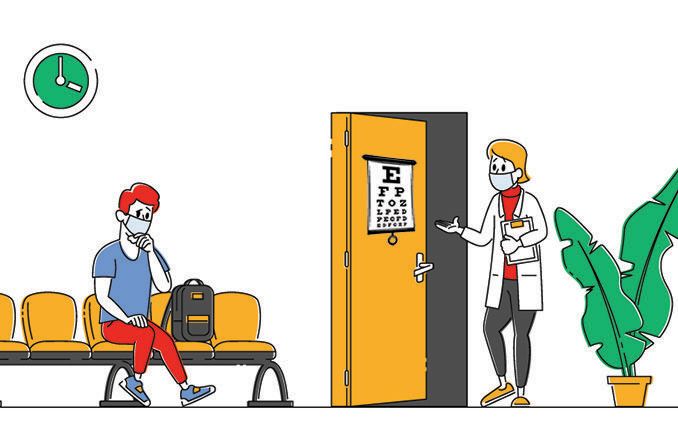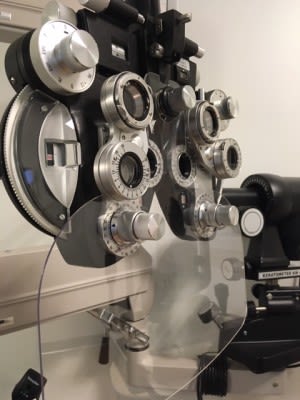Opticians in India use infection control measures to cut Covid-19 risk

The coronavirus pandemic temporarily closed countless businesses across India, but many optometrist offices, optical shops and eye hospitals are open again with added safety precautions in place.
Added safety measures include:
Phone screenings prior to in-office care.
Patient visits are staggered, and everything is sterilized in between appointments.
Face masks, gloves and safety shields are the new standard of safe care for patients and staff.
SEE RELATED: Coronavirus: How eyes may play a role in its spread
Face masks, gloves, face shields to cut COVID-19 risk
During eye care visits, optometrists and staff are doing everything they can to maximize the safety of both patients and employees.
Beyond the now usual face masks and gloves that we all have become accustomed to wearing in recent months, one of the most obvious changes in eye care is the addition of over-sized “shields” specifically for slit lamp procedures.

Eye care practices are adding safety shields to reduce the risk patients and eye doctors might contract the coronavirus during an eye exam.
These plastic or glass shields are something you’ll be seeing a lot more of in the coming months — not only in eye care practices but anywhere that requires face-to-face interaction. You’ve probably already seen these shields in the checkout lane at your grocery store.
How eye exams are being made safer across India
Dr. Monica Chaudhry, currently director of the School of Health Science at Ansal University in Gurugram, detailed the additional safety measures optometrists and eye hospitals are taking to reduce the risk of coronavirus transmission during eye exams.
Chaudhry, who also is a member of the All About Vision editorial advisory board, and a team of optometrists prepared guidelines and have shared then with the All India Ophthalmological Society of India (AIOS) for endorsement.
How eye care has changed in recent weeks
These guidelines are specific to optometrists and optical centers across India:
Wear face masks: The eye care examiner must wear a mask, protective eyewear and face breath shield during close procedures. Aprons, if worn, must be washed daily. Gloves are not mandatory but in case they are worn they must be disinfected after each eye exam.
Encourage e-payments: Cash should be handled with gloves on and team members also should use sanitizer after handling cash.
Limit patient time in office: One patient at a time should be examined and that examination should be without an attendant, if possible. Systems should be streamlined to avoid waiting time and quicken the process so that no unnecessary extra time is spent by patients in the premises (this includes spacing of appointments and, taking patient details and history by phone before the patient arrives).
Equipment sanitization: All instruments, torch, slit lamp, AR, etc., should be disinfected with alcohol wipes after every eye examination. If a near visual acuity chart is made of cardboard and cannot be sanitized, disposable photocopy prints may be used for Near VA recording. Color vision, stereopsis, etc., should be avoided as much as possible during this time.
Keep appointments brief: Vision tests should be done as fast as possible to have minimum contact time with the patient.
Focus on essential care: All non-essential tests are to be avoided/deferred for the future and it is recommended to have only the must-have tests for vision problem management.
SEE RELATED: Eye doctors add teleconsultations due to COVID-19
How eye exams have changed:
Sanitize everything: Wash hands/sanitize at the beginning of each procedure. Trial eyeglass frames MUST be sanitized with alcohol wipe and left to dry after every use, and it is suggested to have two frames. For equipment and equipment parts that come in contact with the eye, use alcohol wipes to disinfect the applanation tonometer, gonioscope, pachymeter, axial length probe should be disinfected as per All India Ophthalmological Society guidelines.
Signs assure patients that the eye exam room has been sanitized.
Practice social distancing: No handshake for greeting. Safe distance (3 feet if possible) should be maintained in all eye exam procedures, and physical contact should be minimized. Avoid touching the face.
Use phone screens: Take a patient's history by phone during the booking of appointments to minimize the examiner's contact time with the eye care patient.
Require patients to do more: The patient will be asked to remove his or her own spectacles, contact lenses, pulling lower lid for eye drop insertion (using a tissue paper), self-occlusion with hand to record visual acuity, etc.
Defer non-essential eye care: Patients with normal 20/20 visual acuity distance and near, may have a deferred eye examination and refraction until the coronavirus situation is under control. Cross cylinder/astigmatic fan test also may be avoided. Retinoscopy bars are recommended and AR should be avoided if not essential. Refraction under cycloplegia should only be done if essential. The drops should be instilled at home or outside the waiting area, maybe in the patient’s car. Patient contact areas should be cleaned with alcohol wipes, such as the forehead and chin rest of the AR, keratometer and slit lamp, trial frame and torch. Breadth shield cannot be used for keratometer, but the examiner may use it himself or herself.
Renew, extend prescriptions (if needed): Existing glasses users with normal satisfactory visual acuity may be prescribed the same glasses.
Install shields for added protection: A slit lamp should have the barriers and/breath shield, preferably sanitized after each patient appointment.
Keep sanitizer within reach: Disinfectants should be kept handy, and equipment which is frequently used should be disinfected frequently, and tables and furniture should be disinfected every two hours.
Encourage contact lens hygiene: Contact lens use is fine during the pandemic, as long as wearers adhere to guidelines covering hygiene. Eye care practitioners in India are following international contact lens protocols as recommended by leading global organizations.
Offer new customer service options: Encourage home deliveries through courier and outside-the-shop deliveries.
Eye care has changed as a result of the coronavirus pandemic, but all of the added safety measures are aimed at keeping you safe and reducing your risk (and your eye care team's risk) of contracting the virus that causes COVID-19.
Optometrist offices, optical shops and eye hospitals are reopening across India. If your vision is blurry or you need your glasses fixed (children at home have a tendency to break things), find an optometrist or optical shop near you and schedule an appointment.
READ NEXT: 7 ways to reduce screen time during the pandemic
Page published on Wednesday, 17 June, 2020







